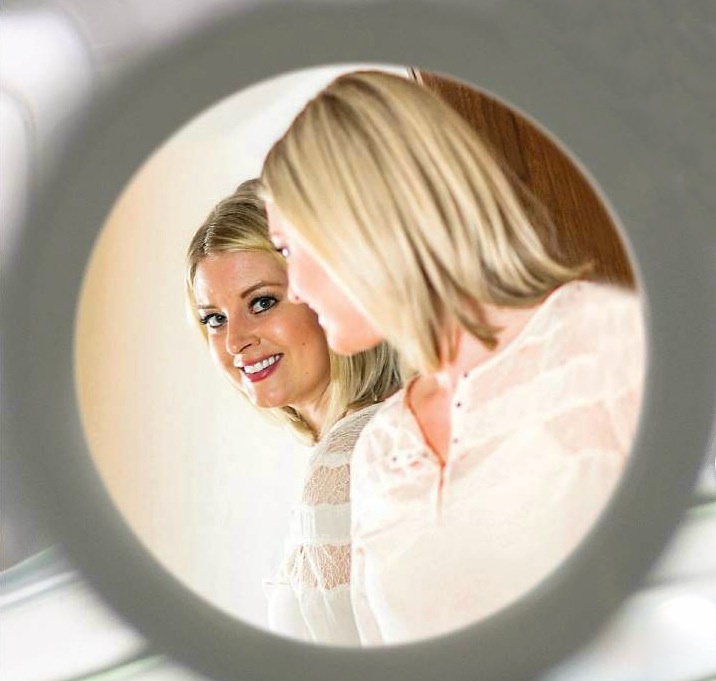A year without mirrors: Kjerstin Gruys goes 365 days without checking herself out
Monday, March 3, 2014
IF YOU GO* What: "Beauty: Bodies from the Personal to the Political," lecture by Kjerstin Gruys.* When: 7:30 p.m. tonight.* Where: UTC University Center Auditorium, East Fifth Street on campus.* Admission: Free.* For more information: www.utc.edu/womens-center.
Six months before her wedding day, Kjerstin Gruys swore off mirrors.
Even with one of the most important days of her life approaching, she made a vow to go one year without looking at her reflection. And she did it - amping up her self-esteem as she learned to place value in herself as a person rather than how society told her she should look.
"I covered mirrors in my home. I really tried to be conscious during my commute to work about all the times I might see my reflection in store windows or a newly washed car and avoid looking. The biggest piece of the project was training myself to look away," describes Gruys, whose name is pronounced KEER-stin GRIZE.
A sociologist, she held a mirror up to the beauty ideals set by media and pop culture to show how they reflected on femininity and body image. She recorded the year that changed her self-perception in her book, "Mirror, Mirror Off the Wall: How I Learned to Love My Body by Not Looking At It for a Year."
She has appeared on "20/20," "The Colbert Report" and "Good Morning, America" and today she is in Chattanooga. She will give a free talk at 7:30 p.m. in the UTC University Center in conjunction with Women's History Month and to raise awareness about eating disorders.
"I think that self-image is a constant problem for women in our society. We want them to think more about their holistic health and not the number on the scale or their reflection in the mirror," says Cassie Nice, assistant director of the University of Tennessee at Chattanooga Women's Center.
In her talk tonight, Gruys will share what she learned from testing her self-esteem.
"I had his hidden assumption that the time and energy and stress I was putting into my appearance paid off in some way, made me more lovable or likeable," says Gruys. "This taught me it was OK to let go, be myself and surround myself with people who are worth my time.
"Whether I'm having a good or bad hair day isn't going to affect my self-esteem, it's all the other things that I do."
Shopping for her bridal gown, ironically, was the catalyst for Gruys' social experiment.
"Instead of feeling excited, I was really critical of my body as I tried on dresses. I felt bad about my body. Then I became angry over having felt the other two emotions," she says.
This wasn't a case of a plus-size woman who couldn't find a gown that fit. Gruys is a size 10.
At the time, she was pursuing a Ph.D. in sociology at UCLA with her research exploring the relationship between physical appearance and social inequity. She had a background in fashion, as well, having worked for Abercrombie & Fitch Corporate and Gap Inc.
Yet, standing in that dressing room, she was still intimidated by society's message about what constitutes beauty.
"As someone who suffered from and recovered from anorexia, I'm very sensitive to how our culture tells women we aren't good enough unless we are very thin. It wasn't so much that I thought I was fat, but that I was being critical of myself although I knew I was a healthy weight for my body type," she says.
As Gruys describes herself, she was a "body-image expert with a body-image problem."
While flying home to California the day after that shopping trip, she read a story about an order of nuns in Renaissance Italy who never looked in mirrors for their entire lives in order to preserve their religious beliefs about vanity. Inspired, she says she "went on the clock the next day."
The first month she focused on "conditioning," she says. Doing hair and makeup without mirrors posed a challenge - frequently leaving her with a telltale black dot of mascara on the side of her nose.
"I wore tinted moisturizer on my face and sheer cream eye shadow, but the trickiest part was mascara. I'm naturally blond and my eyelashes are blond. I had to train myself to watch the mascara wand as it came toward my eye," she describes, laughing.
By the time her wedding day arrived, Gruys was halfway though her experiment. She says she relied on her family and bridesmaids to help her dress and ensure that she was camera-ready for the ceremony.
"On one hand, it was the day I had thought about the most and, on the other hand, it was the easiest day of all because I was the center of attention, surrounded by my family, and I knew none of them would let me walk down the aisle with mascara on my face," she recalls.
Contact Susan Pierce at spierce@timesfreepress.com or 432-757-6284.

